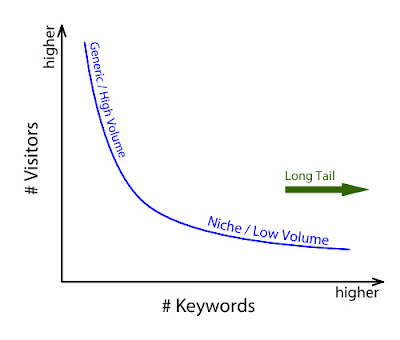I gave a seminar last week on social search optimisation, which was about optimising your blog, twitter, Linked In, You Tube videos so they all appear in the search engines on the specific terms related to your products and services.
Some one then asked me about the difference between generic and niche key phrases and how to identify them………which got me thinking about the best way to explain it to a
newbie.
The Long Tail
This is a niche business strategy that states:
‘Our culture and economy is increasingly shifting away from a focus on a relatively small number of “hits” (mainstream products and markets) at the head of the demand curve and toward a huge number of niches in the tail. As the costs of production and distribution fall, especially online, there is now less need to lump products and consumers into one-size-fits-all containers. In an era without the constraints of physical shelf space and other bottlenecks of distribution, narrowly-targeted goods and services can be as economically attractive as mainstream fare. (http://www.longtail.com)
So how’s this relate to key phrase research?
When using a tool to research your key phrases (such as Google Keyword tool) you will get a mixture of key phrases which range from high volume to low volume; one key word to 3, 4 or 5 key words……..but how do you choose which are the most relevant for your products and services?
The generic, high volume keywords:
- are highly competitive
- take longer to achieve rankings
- will drive high volume of visitors
- will have lower conversions
The more niche, lower volume keywords:
- will be less competitive
- will drive lower volume of visitors
- take shorter length of time to achieve rankings
- higher conversions
However, the long tail also represents the process by which customers refine their search and move from the generic searches into the niche searches.
How this reflects the customer search process
When a person starts researching a product or service they start off quite generic in their searches as they are unclear exactly what they are looking for. So the terms used are the generic key phrases.
When they understand further about the attributes of the product or service, they then refine their search to include the attributes, so they key phrases become longer and more niche. The customers naturally move down the slope on the long tail, through their search / buying process.
Customers will be more likely to purchase from a site if they have appeared in a niche term compared to a general term. Which is why it is important to understand your business goals / products and services to ensure that you match up these to your key phrase research.
However, you need to ensure that you have identified the key phrases along the long tail that the customer might use and include these in your campaign.
Years ago I went to a seminar run by E-Consultancy in Manchester and the marketing director from a large travel organisation was talking about the branding perspective of PPC. They had done a huge overhaul of their PPC and removed all the generic terms which had a low conversion rate or high cost per acquisition, thinking this would improve the overall performance of the campaign. Quite the reverse happened and the overall performance decreased.
This was due to the branding aspect of appearing in the PPC listings. If an ad appears in the listings throughout the long tail of customer research, then, the customer will be more probable to click and purchase on that site compared to a site that only appears solely in the generic or on the niche terms.
This theory applies to search engine optimisation or even social search optimisation. Ensuring your website appears in the listings for the long tail specific to your business is essential for the success of your campaign.
So when doing your keyword research think about the long tail for your key words and get a good distribution of phrases in your campaign.
